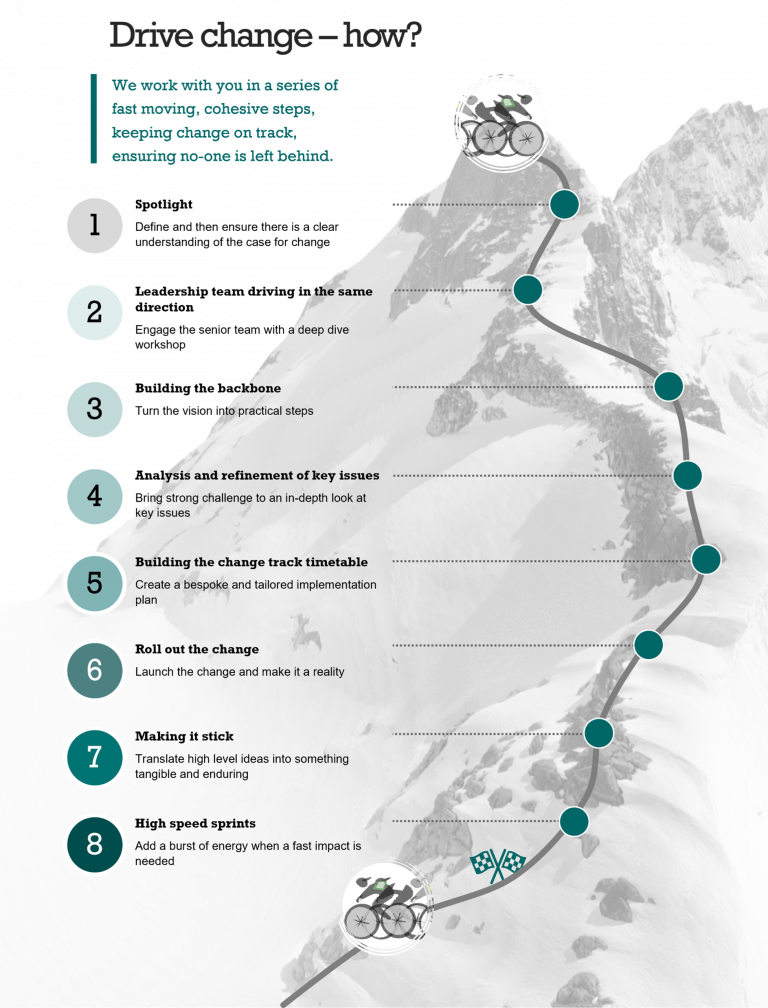
Unlocking Transformation: Overcome 7 Common Barriers When Implementing Change in Business
If you’re trying to make changes in your business, whether to your processes or on an organisational level, it’s important to know what hurdles you may come across so you can plan a route over them.
“Why can we implement change in the short term, but not keep it going?”
“Why isn’t this new process working?”
“Why aren’t our people buying-in to our vision of the future?”
As change specialists, we’ve heard many reasons why organisations say they can’t implement change or make it stick. And it’s because change is tough. It’s uncomfortable pushing ourselves and our people out of our comfort zones, and this leads to many barriers to implementing change successfully.
If you’re trying to make changes in your business, whether to your processes or on an organisational level, it’s important to know what hurdles you may come across so you can plan a route over them. From our experience, here are our top 7 common barriers when implementing change, how to overcome them and how to make change stick.
1. Lack of Leadership Support and Buy-In
Leaders set the tone for change, so if top-level management fails to advocate for change ardently, it stifles the enthusiasm and commitment from others.
One of the most common oversights when it comes to implementing change is not focusing enough on the ‘people’ aspect of the process. That’s why, when we work with our clients, we put a lot of emphasis on the human element of change, starting with aligning a clear vision with leadership values.
If you engage your leaders as “change champions” from the start, they can communicate the benefits with their teams, model desired behaviours and habits, and encourage a culture of teamwork, propelling successful transformation. Managers should also strive to reassure employees about their role in the transformed organisation. All of this means you need to work to make sure your leaders REALLY believe the change. There’s no benefit in rushing through their approvals to get on with the journey as it will unseat you further down the line – take the time to build their understanding, buy-in and engagement at the beginning, and then recruit them as the strongest advocates as you take the rest of the organisation through it.
2. Inadequate Change Vision and Strategy
Another barrier to lasting change is having an inadequate vision and strategy. If you don’t know what the future looks like after the change is implemented, you won’t be able to communicate this to your people or get them onboard.
You need to create a clear vision that aligns with organisational goals and a robust change strategy that outlines how every team member or department contributes to the change’s success. But much more than that, your change vision needs to be inspiring and tell the people in the organisation how things are going to feel different in the future.
To implement lasting change in an organisation, you need to be able to give your organisation, your stakeholders, and your people, a clear idea of this better future. You need to be able to tell them why they should let go of the way things are usually done, put extra effort and hard work into changing the present, and follow senior leadership into the future. This needs to be in terms they understand, reflect how their days will be different, and really get them bought into that future vision.
_________________
Need help creating a clear change vision? Find out why Rich Pictures are a key tool.
_________________
3. Resistance to Implementing Change
Fear of the unknown or perceived threats to the status quo can instigate resistance among your people.
If your people don’t know why changes are being made, they are going to cross their arms and say “no thank you, I’d rather not.” And that can seriously impact whether a change is implemented successfully and whether it lasts.
Since your people are the ones with their boots on the ground, it’s their behaviours and habits that are going to make the difference, and it’s often them who are feeling the pain of the current, so communicate with them honestly with the reason why you’re making the changes. Always approach change with an open dialogue, empathy, and support and recognise that no communication is too much when you’re going through change. Don’t worry about waiting until everything’s clear before communicating, you need to build authentic comms that can cope with letting people know when you don’t know the answer yet, and when you get things wrong. Clear and consistent communication alleviates confusion and cultivates engagement, and this should continue even after changes have been made. You will need to get feedback, address any concerns, and reinforce commitment to the new practices.
_________________
Want to get buy-in from your people? Read: Winning hearts and minds: strategies for getting buy-in for change
_________________
4. Fragmented Organisational Structure
Collaboration is key for successful change, and a siloed structure can obstruct this.
Change is disruptive, chaotic and results in power and knowledge disparities across organisations. If your organisation has a siloed business structure this is going to make the situation even worse – this might even be the thing you’re trying to change! What’s worse is that often change programmes themselves can evolve into their own siloed structures. The way to address this is to really look at the governance and structure of your change programme and make sure you’re doing all you can to foster cross-functional cooperation, dismantle barriers and celebrate and deliver collective success. To do this, encourage collaboration through regular team meetings, shared projects, or task forces specifically aimed at promoting organisational cohesion and communication.
5. Unrealistic Expectations and Timelines
Overambitious expectations can pressure employees and produce subpar results.
Striking a balance between aspiration and realism is crucial, and achievable timelines can ease stress and promote diligent, quality work. Regular progress reviews help keep efforts on track and make necessary adjustments, ensuring the change process remains manageable and focused. There’s a real balance in change programmes between keeping the pressure on and making sure the foot doesn’t come off the gas, and making sure that you’re taking into account how the change is landing, and the capacity of the organisation to cope with the change landing on it. Regular reviews, and bringing in external perspectives, can give you an impartial view of how progress is developing. You then need to find a way to have the honest conversation at leadership level about what’s in the best interests of the organisation. Sometimes that’s pressing on despite organisational resistance, and sometimes it means adjusting the schedule based on the experience you’ve learned as a result – knowing the difference between the two may need an external view.
_________________
Speak to us about our change maturity assessments, and how we work to bring external, objective, challenge to organisations going through change.
_________________
6. Ignoring Organisational Culture When Implementing Change
Neglecting existing culture can impede change efforts.
It’s easy to say that you should align change initiatives with the organisation’s culture and values, but quite often the change you’re trying to put in place directly requires a shift to that culture, and that can be particularly problematic. If you can deliver the change you want to achieve by keeping aligned with your existing culture then the change will resonate with employees, leading to wider acceptance. Additionally, consider culture-specific communication and implementation strategies to reinforce alignment and boost the likelihood of successful adoption. This may include coming back to the core ‘why’ of your organisation, and making sure all your change messaging is reflective of that broader cause or purpose.
And if the change you are putting in requires a change to culture or behaviours, then recognise this is a major change that will require significant and specialised support. We will cover culture change in a future blog, but in summary focus on three primary things:
- firstly break down the change into a few simple outcomes – don’t overcomplicate it;
- secondly describe the explicit behaviours you want to see, and what you don’t want to see;
- and finally, actively reward good behaviours and publicly address negative ones.
Whilst culture change requires more than just these three elements, they are a good set of first steps!
7. Recognise and Support Change Fatigue
Frequent changes without adequate adjustment periods can induce change fatigue.
Change is tiring, for individuals and for organisations. Organisationally it means choosing the change you will undertake and making conscious choices to continue with some change, and to stop others when you don’t believe it’s delivering what you want. Employees will get on board with change if they can see that you’re only choosing to do the things that are important and urgent. Where you have choice, look to pace change and allow time for acceptance – don’t take change teams off the project as soon as the first phase of transition is complete. Seeing change through right into embedding gives better results. And then for individuals it’s about recognising the toll that change can make. Provide support and offering regular check-ins or well-being initiatives can help maintain motivation and productivity. This is particularly important for your change team themselves. Regular team off-sites and away days allow them to collect their energy, have a sense of ‘home team’ support, and be ready to return to the fray with energy and enthusiasm to carry your change vision into the wider organisation.
Address the Human Element and Unlock Transformation
What’s common in all of the above? It’s that implementing change can feel overwhelming, especially when you are experiencing one or more of the barriers above. But if you focus on your people, trust us when we say, this is the key to unlocking transformation.
It’s easy to lose sight of the emotional and behavioural aspects of change while you’re keeping your eyes on the strategic and technical elements, but this is what is needed to achieve lasting and successful change. Communicate clearly with all departments, engage your leaders, and prioritise creating the culture you need to make your change vision a lasting reality.
Caroline Gowing
Email: carolinegowing@jaconsulting.co.uk
LinkedIn: www.linkedin.com/in/carolinegowinggreenslade
About Caroline Gowing – Caroline is an expert sustainability and change management consultant delivering successful change across Defence, wider corporate business, and the charity sector for the past twenty years.
A highly competent strategy and change management facilitator Caroline is able to work with an individual or group to draw out their understanding of a problem and solution and then take this forward in a way that can be easily understood, persuasively communicated and attractively presented.

Need help with making change that lasts?
At JA Consulting, we specialise in not just any change – we engineer transformations that truly resonate with your organisation. Those elusive changes that you’ve known you needed, but somehow always slipped through the cracks. The kind of change that once implemented, leaves you wondering how you ever managed without it.
To build a resilient business strategy fit for the future, you need more than just a plan – you need a comprehensive blueprint and implementation strategy. And that’s exactly what we offer. But we don’t stop there. We go the extra mile to ensure these changes are not merely fleeting adjustments, but long-lasting improvements.
Why wait? Reach out to us today, and we can show you how to deliver lasting change that sticks.
_____
And a final thought
At JA Consulting we help drive sustainable change; to work with you to take theory and put it into practice. With the right support and guidance, change can become a seamless and straightforward process that yields long-term results.
Want to make change happen for you? Our team is waiting and ready to help.

